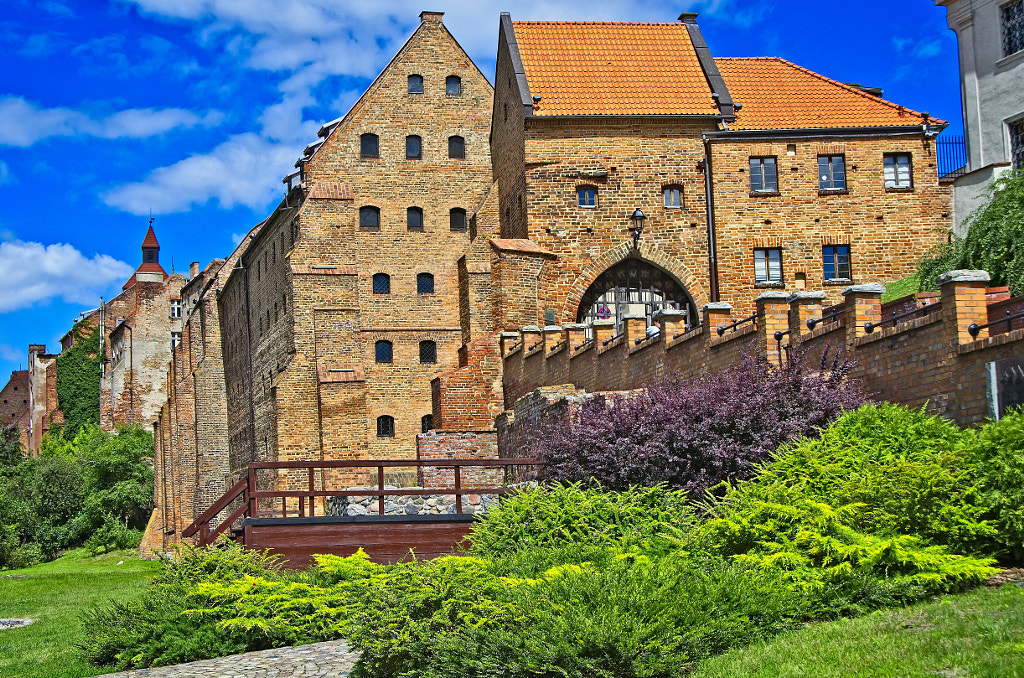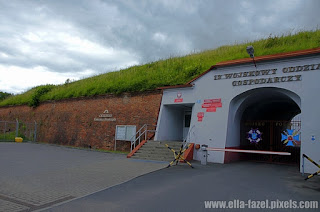Gothic granary and Water Gate (Brama Wodna) of Grudziadz.

The oldest historic sites of Grudziądz are its earliest brick buildings, erected during the reign of the Teutonic Knights, including the castle ruins, the Basilica of St Nicholas, and the city walls with the Water Gate.
A group of distinct, monumental granaries, creating a unique panoramic view across the Vistula, date back to the late Middle Ages. The turn of the 18th century is remembered in Grudziądz for three beautiful monasteries, namely the convent of the Benedictine nuns, the monastery of the Order of the Reformat and the Jesuit monastery.
Over The River Vistula In Grudziadz Poland
During the partitions of Poland, Friedrich II of Prussia made the decision to build a citadel in Grudziądz. In a short period, a modern and the biggest fortress of Poland was constructed, featuring 5 bastions, 4 ravelins and 32 kilometres of underground galleries.
During the partitions of Poland, Friedrich II of Prussia made the decision to build a citadel in Grudziądz. In a short period, a modern and the biggest fortress of Poland was constructed, featuring 5 bastions, 4 ravelins and 32 kilometres of underground galleries.
Grudziądz, entrance to the citadel
The rapid growth of military craft and construction of a bridge over the Vistula led to expansion of the fortress in the late 19th century. This expansive development of the city fortification system “backfired” on Grudziądz during the liberation battles in winter 1945.
Grudziądz, Castle ruins and 'Klimek' Tower
Grudziądz was turned into a city-fortress, the object of battles between the German and Russian armies that continued for six weeks. In 1945, nearly three-quarters of the city was damaged.
Grudziądz Basilica more
Grudziądz old town
Ułan z dziewczyną to pomnik (2008), który przypomina, że przed drugą wojną światową w Grudziądzu umiejscowiono Centrum Wyszkolenia Kawalerii (CWKaw.). To była ważna szkoła, ze względu na tradycyjnie wysoką rangę tej formacji w polskim wojsku. Została utworzona przez Ministra Spraw Wojskowych w 1920 r. jako Centralna Szkoła Jazdy. Zmieniała potem nazwę i formę organizacyjną wielokrotnie, jako CWKaw. Funkcjonowała od 1928 do 1939 roku. Była to największa tego typu wojskowa jednostka szkoleniowa w Europie. Autorem pomnika jest grudziądzki artysta plastyk Ryszard Kaczor.
Grudziądz
Ułan z dziewczyną to pomnik (2008), który przypomina, że przed drugą wojną światową w Grudziądzu umiejscowiono Centrum Wyszkolenia Kawalerii (CWKaw.). To była ważna szkoła, ze względu na tradycyjnie wysoką rangę tej formacji w polskim wojsku. Została utworzona przez Ministra Spraw Wojskowych w 1920 r. jako Centralna Szkoła Jazdy. Zmieniała potem nazwę i formę organizacyjną wielokrotnie, jako CWKaw. Funkcjonowała od 1928 do 1939 roku. Była to największa tego typu wojskowa jednostka szkoleniowa w Europie. Autorem pomnika jest grudziądzki artysta plastyk Ryszard Kaczor.
Grudziądz
Source text: visitbydgoszcz.pl, krajoznawcy.info.pl
Fot. Elżbieta Fazel.






Brak komentarzy:
Prześlij komentarz